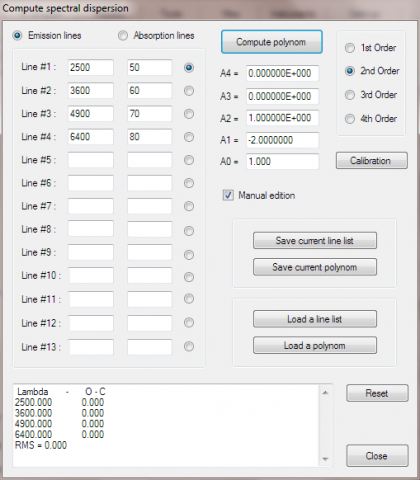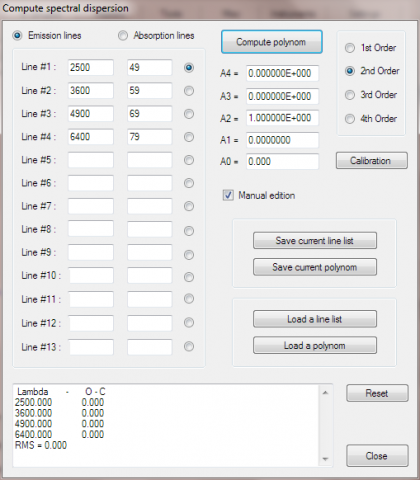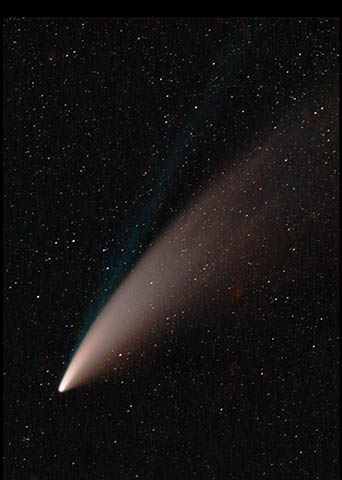› Forums › Spectroscopy › Help with ISIS
- This topic has 15 replies, 5 voices, and was last updated 8 years, 11 months ago by
 David Boyd.
David Boyd.
-
AuthorPosts
-
9 January 2017 at 12:11 pm #573666
 john simpsonParticipant
john simpsonParticipantI’m running V5.8.0 in Windows 10 and working through ALPY spectral calibration [method 1 from C.Buil’s site translated by Robin Leadbeater]. Using just 4 images of HD27819 to try it out. All is OK, spectrum calibrates, log file shows research lines are within +/-7px and RMS~0.5A. However click on “Dispersion” button shows A0-A4 with all zeros and no pixel data in boxes [the 7 wavelengths shown but with no pixel readings range from 6382.992 – 6717.043A. These are neon. I have “ALPY without calibration module” selected in “Settings”] . A sensible set of numbers for A0-A4 are recorded in the log file, but don’t appear to be transferred into the “Dispersions” table. I’ve checked that I’m using the same settings shown in the method 1 summary and also restarted ISIS a couple of times, but the table remains empty – wondered if anyone can help?
Attachments:
9 January 2017 at 7:48 pm #577790 Andy WilsonKeymaster
Andy WilsonKeymasterHi John,
That sounds a bit odd. Can I check that the spectrum definitely calibrates successfully. If you hover the mouse over the spectrum plot in tab 5, then do you see sensible wavelength numbers appear for the cursor position in the bottom left of the screen?
Also, you say you are not using the Alpy calibration module. Are you using an A type star, or similar star with prominent hydrogen lines to wavelength calibrate your spectrum? Or are you using a neon lamp source, just not the one that comes with the ALPY, in which case you may be able to select the “ALPY 600 (with calibration module)”.
Cheers,
Andy
9 January 2017 at 9:56 pm #577791 john simpsonParticipant
john simpsonParticipant Hi Andy, Thanks for your quick reply. Yes, hovering over spectrum plot in tab 5 seems OK – very noisy, 4 images done in hurry with poor guiding, but think OK. Too excited with ALPY. Will attach plot. Used HD27819 – Miles – A7v – had aimed to try to follow Robin’s earlier set that he posted, but ran out of weather. Used “Predefined Mode” ALPY 600 (Balmer Lines) in Spectral Box of General tab. This is what appears in log file.
Hi Andy, Thanks for your quick reply. Yes, hovering over spectrum plot in tab 5 seems OK – very noisy, 4 images done in hurry with poor guiding, but think OK. Too excited with ALPY. Will attach plot. Used HD27819 – Miles – A7v – had aimed to try to follow Robin’s earlier set that he posted, but ran out of weather. Used “Predefined Mode” ALPY 600 (Balmer Lines) in Spectral Box of General tab. This is what appears in log file.Wavelength fit deviation
point #1 x = 303.320 lambda = 3834.846 dlambda = 0.544
point #2 x = 318.889 lambda = 3889.410 dlambda = -0.360
point #3 x = 342.002 lambda = 3970.510 dlambda = -0.430
point #4 x = 379.334 lambda = 4101.764 dlambda = -0.014
point #5 x = 446.859 lambda = 4340.099 dlambda = 0.381
point #6 x = 593.448 lambda = 4861.471 dlambda = -0.131
point #7 x = 1081.158 lambda = 6562.787 dlambda = 0.023
point #8 x = 1179.852 lambda = 6872.013 dlambda = -0.013
————————————————————————–
Coefficient a4 : -4.314777E-10
Coefficient a3 : 7.466854E-07
Coefficient a2 : -3.481507E-04
Coefficient a1 : 3.55629
Coefficient a0 : 2767.495
————————————————————————–
RMS : 0.507955
————————————————————————–Don’t have ALPY Calibration Module – need coffers to refill for that. Have fashioned external fixed neon bulb in line with slit as per picture on Robin’s website, but didn’t use that – took some sky plus neon today though to play with later.
Am going to do it all over again next clear spell here, but will keep looking at it – still puzzled.
10 January 2017 at 6:36 am #577792 Andy WilsonKeymaster
Andy WilsonKeymasterHi John,
That is an excellent first spectrum! Anyone starting out in spectroscopy would be very pleased with that. It shows that all of the basics including instrument response have worked as they should. You may as well crop the spectrum at a slightly shorter wavelength as it looks like it is just noise at the far left, but that is a minor point.
To be honest I hardly ever use the “Dispersion” button on tab 5, as the wavelength calibration is usually performed spot on in tabs 3 and 4. I did take a look at the dispersion in tab 5 last night, and it did appear to be populated, but that was in ISIS v5.5.2. It will be interesting to see what others post, but it may be that even if it is not populating you can get by without it, at least for now. What I’m not sure is whether this is an undetected bug, or something to do with how ISIS is used like a setting.
You may also find you get different behaviour with the neon calibration image, if you select ALPY with Calibration module. Though I’m not sure.
Regardless, you are already getting useful spectra with the processing you are doing.
Best wishes,
Andy
10 January 2017 at 6:12 pm #577793 Robin LeadbeaterParticipant
Robin LeadbeaterParticipantHi John,
If you use the “no ALPY calibration module” setting in ISIS it automatically finds and uses the first 7 Balmer lines in the star spectrum, plus the head of the telluric band at 6872A for calibration. Only the resulting calibration fit coefficients are transferred into the dispersion window so you can use them for subsequent calibration of further spectra (using the “predefined dispersion equation” option). The list of lines for manual entry shown there are just what happened to be left over from a previous manual run. If you delete them all for example before making the calibration you should see that only the coefficients are filled in after calibration.
HTH
Robin
10 January 2017 at 7:10 pm #577794 Robin LeadbeaterParticipant
Robin LeadbeaterParticipantCorrection. I just tested this and ISIS (v5.7) does not appear to transfer the calibration fit coefficients to the dispersion window. Perhaps this is a bug introduced in a later version. You can still calibrate other spectra using the Balmer lines in the calibration image as explained at the end of the tutorial part 1 but if you want to use the predefined coefficients described in part 2, I think you would need to transfer them manually.
BTW the translation in some parts is not so good because Christian added some sections later which he translated
Cheers
Robin
11 January 2017 at 3:47 pm #577795 john simpsonParticipant
john simpsonParticipantHi Robin, thanks for looking into this – I’ll do as you suggest and calibrate with Balmer line option for the time being.
john
11 January 2017 at 4:29 pm #577796 David BoydParticipant
David BoydParticipantI use the File mode option under Spectral calibration on the General tab in ISIS 5.7.0. I give it a .lst file with a list of the calibration lines to use in the fit. ISIS then does fill in the calibration fit coefficients in the Dispersion window. It also highlights the 3rd order radio button in that window although the fit is 4th order.
One thing I have noticed is that these coefficients do not generate the correct residuals if you use them in a 4th order polynomial with the measured pixel positions for each calibration line listed in the Go window in the Go tab. If on the other hand you make a 4th order polynomial fit to the measured pixel positions and the correct line wavelengths using eg Excel and then use these coefficients to calculate the residuals for each line, you get exactly the residuals listed in the Go window. These coefficients are not the same as the ones listed lower down in the Go window and in the Dispersion window.
I have no idea what is going on there and where the coefficients listed by ISIS come from but they are not the coefficients of the mathematical fit which produces the residuals listed for each line in the Go window. Perhaps this is a consequence of using File mode calibration? I am only mentioning this in case anyone tries to use the coefficients listed by ISIS to reproduce the residuals and finds they get different answers.
David
11 January 2017 at 8:35 pm #577797 Robin LeadbeaterParticipant
Robin LeadbeaterParticipantHi David,
This anomaly does not seem to be limited to the file mode. I just checked John’s coefficients and the resulting fit posted above and they do not seem to agree either (The residuals are around 3-4 Angstrom)
I’ve no idea what is going on either but the coefficients in the GO window do not seem to be the correct ones to give a good calibration fit so presumably would not work if transferred manually to the dispersion window.
I also went back to v5.4.1 and this does not transfer the coefficients to the dispersion window automatically when using the ALPY 600 balmer line mode either
All very strange
Robin
12 January 2017 at 9:22 am #577798 john simpsonParticipant
john simpsonParticipantRobin et al,
Thought I’d better make it clear that in my original post with the coefficients, I put in copy the lower set that is reported in the log file. . There is an upper set reported call the “primary dispersion” which I couldn’t relate to my pixel data, but guessed it was some master set in ISIS covering 11 different wavelengths, amended by my data in some way to allow setting of the research pixel windows of +/-7. I’m copying this set below anyway, just in case it’s relevant.
————————————————————————–
Primary dispersion :
Coefficient a4 : -2.657745E-13
Coefficient a3 : 7.117650E-09
Coefficient a2 : -6.547758E-05
Coefficient a1 : 0.53625
Coefficient a0 : -971.891
————————————————————————–
RMS : 0.125248 (en pixels)
————————————————————————–
Primary wavelength fit deviation
point #1 Lambda = 3770.630 px = 447.009 dx = -0.091
point #2 Lambda = 3797.300 px = 454.713 dx = 0.211
point #3 Lambda = 3835.390 px = 465.697 dx = -0.107
point #4 Lambda = 3889.050 px = 481.138 dx = -0.018
point #5 Lambda = 3970.080 px = 504.383 dx = 0.059
point #6 Lambda = 4101.750 px = 541.995 dx = -0.068
point #7 Lambda = 4340.480 px = 609.798 dx = -0.023
point #8 Lambda = 4861.340 px = 756.864 dx = 0.054
point #9 Lambda = 6562.850 px = 1246.125 dx = -0.096
point #10 Lambda = 6869.000 px = 1337.306 dx = 0.092
point #11 Lambda = 7605.000 px = 1560.933 dx = -0.012
————————————————————————–
BTW, if I calculate the RMS for the dx above I get 0.09241 and not 0.125248 [maybe it is weighted in some way not disclosed]. The same is true for the dlambda figures noted in my earlier post.
john
12 January 2017 at 12:28 pm #577799 Tony RoddaParticipant
Tony RoddaParticipantInteresting thread. (And as Andy says, an excellent Spectrum John).
I’m not sure what the relationship is between ISIS and Demetra code (that is, whether ISIS code/logic has been reused) but just out of interest I’m still having a little tussle with higher order polys in Demetra calibration. Lower orders are fine and produce excellent results. Anything above three and I sometimes get very strange results.
Rgds
T
12 January 2017 at 1:39 pm #577800 Robin LeadbeaterParticipant
Robin LeadbeaterParticipantOK… The coefficients generated by ISIS using the automatic line finding calibration systems and displayed in the GO window (as used in the predefined and file calibration modes) work correctly if entered into the dispersion function accessible from the profile tab to give the correct calibration so at least ISIS is internally consistent. It is still not clear why using these coefficients in Excel for example does not produce the right results though. Perhaps the primary fit that ISIS does is connected with this. The px values in that fit do not appear to be pixel values so perhaps some resampling is done in this preliminary calibration and the final calibration coefficients are calculated relative to this generic fit? (pure speculation on my part though)
12 January 2017 at 5:51 pm #577801 Robin LeadbeaterParticipant
Robin LeadbeaterParticipantOK I now understand what ISIS is doing when it calculates the coefficients. It adds 1 to all the pixel positions before calculating the fit. You can see this in the attached trivial example where I manually entered a series of wavelengths and pixel positions where the wavelength = pixel ^2 before making a 2nd order fit. It only gave the expected coefficients when I subtracted 1 from the pixel positions.
I still have no idea why though! (For information VSpec calculates the coefficients conventionally)
Cheers
Robin

 13 January 2017 at 9:24 am #577808
13 January 2017 at 9:24 am #577808 David BoydParticipant
David BoydParticipantRobin,
That’s correct. If you add 1 to the CCD pixel positions (which are listed as x= in the Go window) before calculating the 4th order polynomial in Excel, then you get the coefficients ISIS displays in the Go window. However the calibration line dlambda residuals shown in the Go window are computed using a 4th order polynomial based on the original CCD pixel positions.
David
13 January 2017 at 11:38 am #577809 john simpsonParticipant
john simpsonParticipantHi David/Robin,
I am wondering if my interpretation of RMS performance index reported for dlambda is incorrect in this instance? It appears to be sqrt of sum of squares/3. [3 being order of polynomial -1].
john
15 January 2017 at 11:22 am #577811 David BoydParticipant
David BoydParticipantHi John,
To get the value for the rms residual given by ISIS you need to calculate sqrt(sumsq(dlambda values)/6) because you have 11 lines and there are 5 parameters in the fit.
David
-
AuthorPosts
- You must be logged in to reply to this topic.

